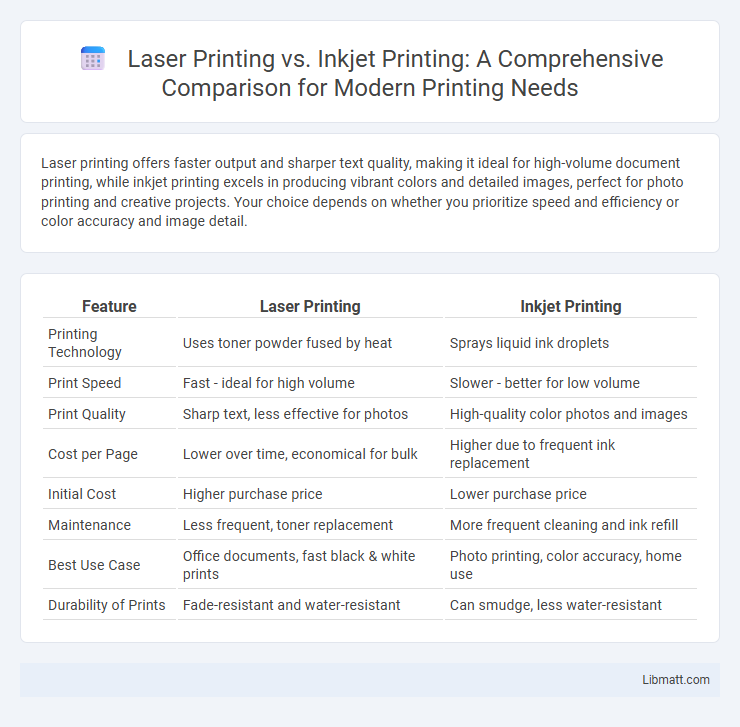Laser printing offers faster output and sharper text quality, making it ideal for high-volume document printing, while inkjet printing excels in producing vibrant colors and detailed images, perfect for photo printing and creative projects. Your choice depends on whether you prioritize speed and efficiency or color accuracy and image detail.
Table of Comparison
| Feature | Laser Printing | Inkjet Printing |
|---|---|---|
| Printing Technology | Uses toner powder fused by heat | Sprays liquid ink droplets |
| Print Speed | Fast - ideal for high volume | Slower - better for low volume |
| Print Quality | Sharp text, less effective for photos | High-quality color photos and images |
| Cost per Page | Lower over time, economical for bulk | Higher due to frequent ink replacement |
| Initial Cost | Higher purchase price | Lower purchase price |
| Maintenance | Less frequent, toner replacement | More frequent cleaning and ink refill |
| Best Use Case | Office documents, fast black & white prints | Photo printing, color accuracy, home use |
| Durability of Prints | Fade-resistant and water-resistant | Can smudge, less water-resistant |
Introduction to Laser and Inkjet Printing
Laser printing uses toner and a laser beam to produce sharp, high-quality text and graphics, making it ideal for fast, high-volume printing tasks. Inkjet printing relies on liquid ink sprayed through tiny nozzles, offering superior color accuracy and detail for photos and graphic-heavy documents. Your choice depends on printing volume, budget, and the desired output quality, with laser printers suited for business documents and inkjets better for vibrant images.
How Laser Printers Work
Laser printers use a laser beam to produce an image on a drum coated with photoconductive material, which then attracts toner particles. These toner particles are transferred onto paper and fused with heat to create precise, sharp text and graphics. Your documents benefit from faster printing speeds and higher durability compared to inkjet printing.
How Inkjet Printers Work
Inkjet printers function by spraying tiny droplets of ink directly onto paper through microscopic nozzles, creating precise and detailed images. This technology is ideal for producing vibrant color prints and smooth gradients, especially on photo paper. Understanding how your inkjet printer operates can help optimize print quality and manage ink usage effectively.
Print Quality Comparison
Laser printing offers sharper text and more precise lines due to its toner-based technology, making it ideal for professional documents and high-volume text printing. Inkjet printers excel in producing vibrant color gradients and detailed images, which is preferred for photo printing and creative projects. While laser prints tend to be more durable and smudge-resistant, inkjet prints provide superior color accuracy and smooth shading for complex graphics.
Printing Speed: Laser vs Inkjet
Laser printing offers significantly faster printing speeds compared to inkjet printing, making it ideal for high-volume tasks and business environments. Inkjet printers typically produce slower output, especially when printing in high resolution or color. Choosing laser printing ensures quicker turnaround times for your documents without compromising on quality.
Cost Efficiency and Consumables
Laser printing offers superior cost efficiency for high-volume printing due to lower cost per page and longer-lasting toner cartridges compared to inkjet printers. Inkjet printing involves higher ongoing expenses as ink cartridges need frequent replacement and are generally more expensive per page. Your choice depends on printing volume and budget, with laser printers favored for bulk printing and inkjets suited for occasional, color-rich tasks.
Suitability for Home and Office Use
Laser printing offers fast, high-volume output ideal for office environments requiring sharp text and efficient handling of large documents. Inkjet printing excels in producing high-quality color images and photos, making it suitable for home use with occasional printing needs. Your choice depends on whether speed and text clarity or vivid color reproduction are your primary requirements.
Performance with Photos and Graphics
Laser printing delivers sharp text and crisp graphics with consistent quality, excelling in producing high-resolution line art and monochrome images. Inkjet printing outperforms in photo printing by producing richer color gradients and finer details, thanks to its ability to blend multiple ink droplets. For vibrant, detailed photos and complex graphics, inkjets generally offer superior color depth and smooth tonal transitions compared to laser printers.
Maintenance and Longevity
Laser printers require less maintenance due to their toner-based system, which reduces the risk of smudging and clogging compared to inkjet printers that use liquid ink cartridges prone to drying out. The longevity of laser printers typically surpasses that of inkjet printers, with durable components designed for high-volume printing environments and extended use. Regular maintenance for inkjet printers involves frequent cleaning cycles to prevent nozzle blockages, whereas laser printers mainly need periodic toner replacements and drum unit checks.
Environmental Impact and Energy Consumption
Laser printing generally consumes more energy per page compared to inkjet printing due to its high-powered laser and fuser unit, leading to increased carbon emissions. Inkjet printers use less electricity and generate less waste, as they require fewer replacement parts and use water-based inks that are often more environmentally friendly. The environmental impact of laser printers is further amplified by toner cartridges, which contain plastic and chemical components that are harder to recycle compared to inkjet cartridges.
laser printing vs inkjet printing Infographic

 libmatt.com
libmatt.com